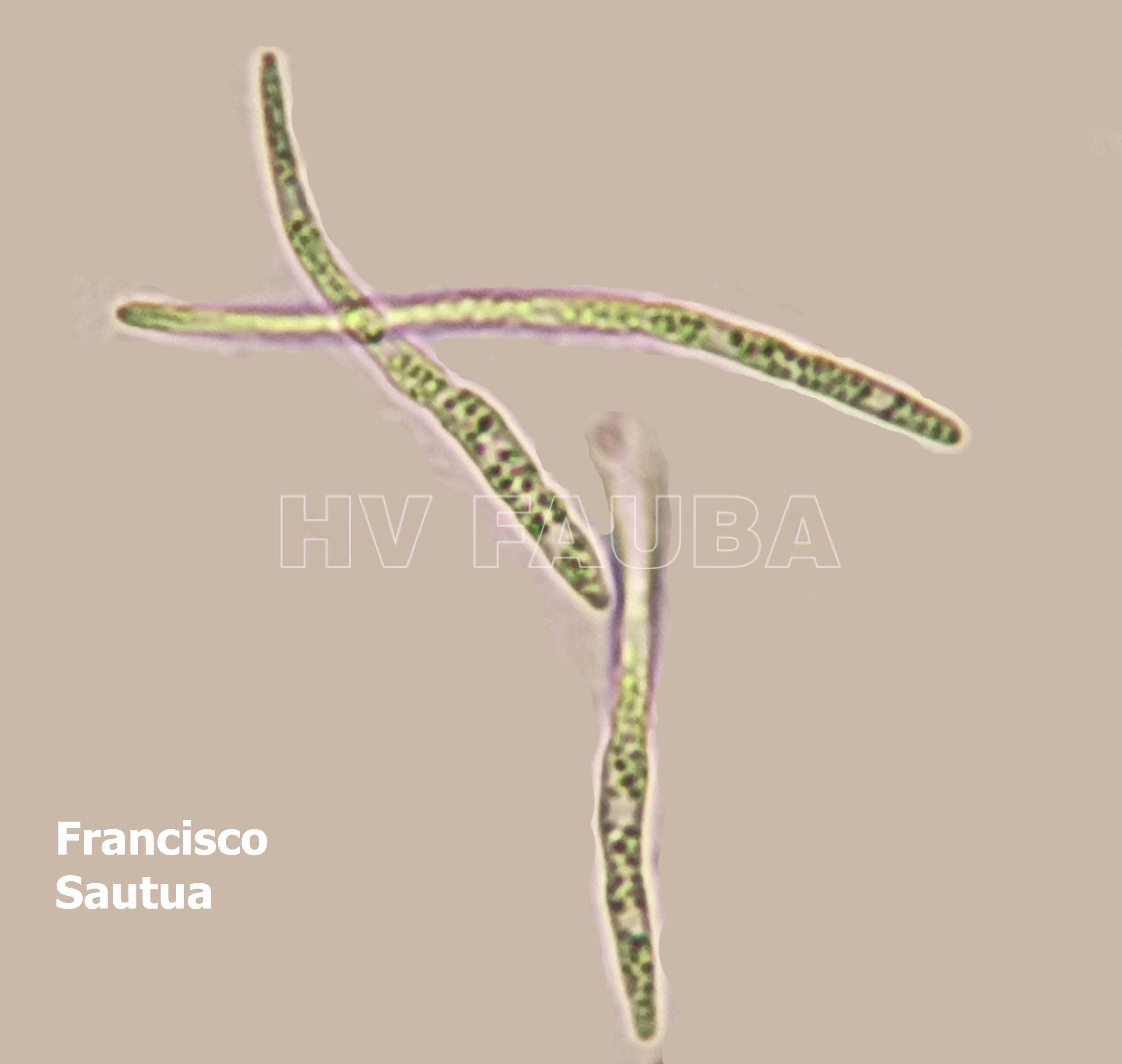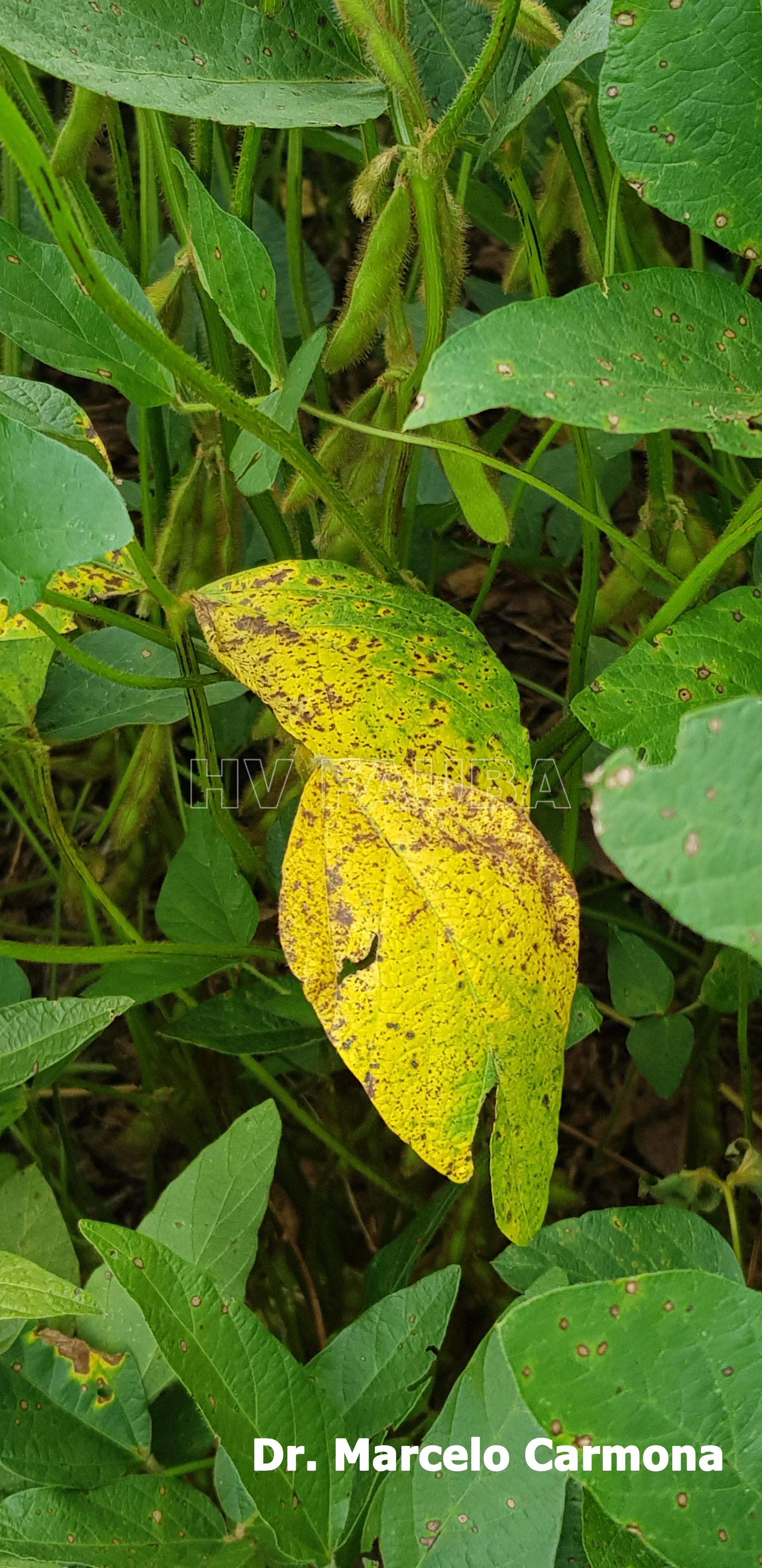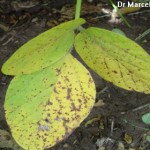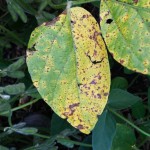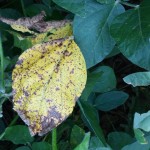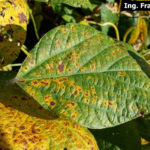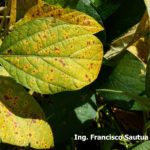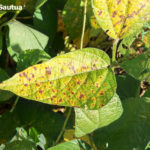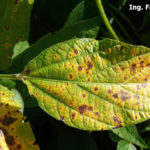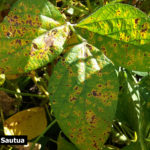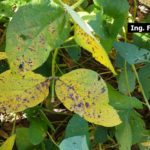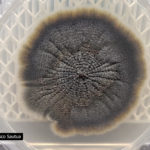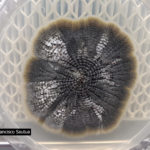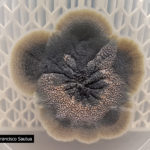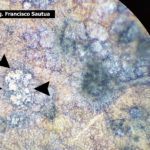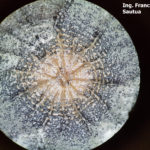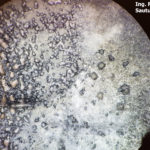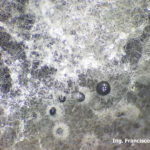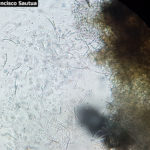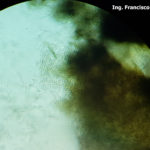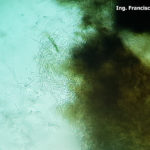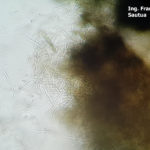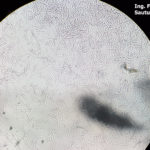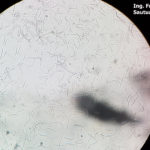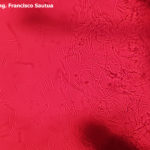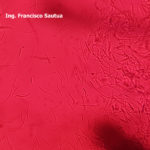.
Condición fitosanitaria: Presente ampliamente distribuida
Grupo de cultivos: Oleaginosas
Especie hospedante: Soja (Glycine max)
Rango de hospedantes: específico / estrecho
Rango de hospedantes: específico / estrecho, la mayoría de las especies de Glycine spp, otras especies de leguminosas y malezas comunes como Abutilon spp.
Etiología: Hongo. Necrotrófico (Hemibiotrófico)
Agente causal: Septoria glycines Hemmi
Taxonomía: Eukaryota > Fungi > Dikarya > Ascomycota > Pezizomycotina > Dothideomycetes > Capnodiales > Mycosphaerellaceae > Septoria
.
.
- Conidios de Septoria glycines
.
.
.
Síntomas y signos
Los síntomas pueden observarse desde estadios tempranos (vegetativos), en los cotiledones y hojas basales. Luego su presencia pasa inadvertida hasta inicios de floración, cuando se observan por manchas foliares angulares a irregulares de color marrón. Los síntomas siempre comienzan por las hojas inferiores. Cuando la hoja aun esta verde, se observa un nítido halo clorótico. Luego el amarillamiento se generaliza y se produce la defoliación que avanza de la base hacia la parte superior de la plantas.
.
.
.
Condiciones predisponentes para el establecimiento y dispersión de la enfermedad
Temperaturas óptimas de 25 ºC, tiempo húmedo, lluvias con vientos. Las salpicaduras favorecen la dispersión ya que el hongo forma picnidios que liberan los conidios inmersos en una matriz mucosa.
.
Daños
Alta importancia relativa.
.
Manejo Integrado
* Rotación de cultivos
* Uso de semilla sana o tratada con fungicidas
* Correcta nutrición del cultivo
* Aplicación foliar de fungicidas de acuerdo con criterios técnico-científicos.
.
- 01 Síntomas foliares de la Mancha Marrón de la soja, causada por Septoria glycines. Autor: Ing. Francisco Sautua.
- 02 Síntomas foliares de la Mancha Marrón de la soja, causada por Septoria glycines. Autor: Ing. Francisco Sautua.
- 03 Síntomas foliares de la Mancha Marrón de la soja, causada por Septoria glycines. Autor: Ing. Francisco Sautua.
- 04 Síntomas foliares de la Mancha Marrón de la soja, causada por Septoria glycines. Autor: Ing. Francisco Sautua.
- 05 Síntomas foliares de la Mancha Marrón de la soja, causada por Septoria glycines. Autor: Ing. Francisco Sautua.
- 06 Síntomas foliares de la Mancha Marrón de la soja, causada por Septoria glycines. Autor: Ing. Francisco Sautua.
- 07 Síntomas foliares de la Mancha Marrón de la soja, causada por Septoria glycines. Autor: Ing. Francisco Sautua.
- 08 Síntomas foliares de la Mancha Marrón de la soja, causada por Septoria glycines. Autor: Ing. Francisco Sautua.
- Mancha Marrón de la soja causada por Septoria glycines. Autor: Dirceu Gassen
- 01 colonia de Septoria glycines creciendo en APG
- 02 colonia de Septoria glycines creciendo en APG
- 03 colonia de Septoria glycines creciendo en APG, con abundantes cirros
- 01 Cirros de Septoria glycines sobre hoja de soja. Autor: Ing. Francisco Sautua.
- 02 Cirros de Septoria glycines sobre colonia creciendo en PDA. Autor: Ing. Francisco Sautua.
- 03 Cirros de Septoria glycines sobre colonia creciendo en PDA. Autor: Ing. Francisco Sautua.
- 04 Cirros de Septoria glycines sobre colonia creciendo en PDA. Autor: Ing. Francisco Sautua.
- 01 Conidios de Septoria glycines. Autor: Ing. Francisco Sautua.
- 02 Conidios de Septoria glycines. Autor: Ing. Francisco Sautua.
- 03 Conidios de Septoria glycines. Autor: Ing. Francisco Sautua.
- 04 Conidios de Septoria glycines. Autor: Ing. Francisco Sautua.
- 05 Conidios de Septoria glycines. Autor: Ing. Francisco Sautua.
- 06 Conidios de Septoria glycines. Autor: Ing. Francisco Sautua.
- 07 Conidios de Septoria glycines. Autor: Ing. Francisco Sautua.
- 08 Conidios de Septoria glycines. Autor: Ing. Francisco Sautua.
.
.
.
Bibliografia
Batzer JC, Kandel YR, Bradley CA, et al. (2016) Effect of Seed Treatment on Early Season Brown Spot Caused by Septoria glycines of Soybean. Plant Health Progress 17: 223-228. doi: 10.1094/PHP-RS-16-0035
Brogin C, Arias C, Toledo J (2003) Genetic control of soybean resistance to brown spot (Septoria glycines): first studies. Cropp Breeding and Applied Biotechnology 3(1): 35–44. doi: 10.12702/1984-7033.v03n01a05
Carmona M, Moschini R, Cazenave G, Sautua F (2010) Relación entre la precipitación registrada en estados reproductivos de la soja y la severidad de Septoria glycines y Cercospora kikuchii. Tropical Plant Pathology 35: 71-78. doi: 10.1590/S1982-56762010000200001
Carmona M, Sautua F, Perelman S, et al. (2015) Development and validation of a fungicide scoring system for management of late season soybean diseases in Argentina. Crop Protection 70: 83-91. doi: 10.1016/j.cropro.2015.01.019
Carmona MA, Sautua FJ, Pérez-Hernández O, Mandolesi JI (2018) AgroDecisor EFC: First Android™ app decision support tool for timing fungicide applications for management of late-season soybean diseases. Computers and Electronics in Agriculture 144: 310-313. doi: 10.1016/j.compag.2017.11.028
Carmona MA, Sautua FJ, Pérez-Hernández O (2019) Copper phosphite enhances efficacy of a strobilurin-triazole fungicide in controlling late season foliar diseases of soybean. Crop Protection 115: 130-134. doi: 10.1016/j.cropro.2018.09.019
Chalfoun NR, Durman SB, González-Montaner J, et al. (2018) Elicitor-Based Biostimulant PSP1 Protects Soybean Against Late Season Diseases in Field Trials. Front. Plant Sci. 9: 763. doi: 10.3389/fpls.2018.00763
Cruz CD, Mills D, Paul PA, Dorrance AE (2010) Impact of Brown Spot Caused by Septoria glycines on Soybean in Ohio. Plant Disease 94(7): 820-826. doi: 10.1094/PDIS-94-7-0820
SX (2021) Characterization of Septoria brown spot disease development and yield effects on soybean in Illinois. Canadian Journal of Plant Pathology, 43: 62-72. doi: 10.1080/07060661.2020.1755366
Lin HA, Mideros SX (2021) Accurate quantification and detection of Septoria glycines in soybean using quantitative PCR. Current Plant Biology 25. doi: 10.1016/j.cpb.2020.100192
Lin HA, Mideros SX (2023) The effect of Septoria glycines and fungicide application on the soybean phyllosphere mycobiome. Phytobiomes Journal 7: 220-232. doi: 10.1094/PBIOMES-12-21-0075-R
Martinenko NV, et al (2021) Effect of Septoria on the specific activity of Glycine max (L.) Merr hydrolases. IOP Conf. Ser.: Earth Environ. Sci. 677: 052089. Link
Martynenko N, Lavrentieva S, Tarasova O (2021) Influence of Septoria glycines Hemmi on the enzymes’ activity of hydrolytic Glycines max (L.) Merr seed complex. E3S Web of Conferences 254, 02020. doi: 10.1051/e3sconf/202125402020
Neves D, Wang A, Weems JD, et al. (2022 ) Identification of Septoria glycines Isolates from Soybean with Resistance to Quinone Outside Inhibitor Fungicides. Plant Disease 106: 2631-2637. doi: 10.1094/PDIS-08-21-1836-RE
Nian J, Yu M, Bradley CA, Zhao Y (2021) Lysobacter enzymogenes strain C3 suppresses mycelium growth and spore germination of eight soybean fungal and oomycete pathogens and decreases disease incidences. Biological Control 152: 104424. doi: 10.1016/j.biocontrol.2020.104424
Sequín CJ, Sampietro DA, Sgariglia MA, et al. (2020) Use of extracts from Prosopis nigra in the control of Cercospora kikuchii and Septoria glycines. Industrial Crops and Products 158: 112979. doi: 10.1016/j.indcrop.2020.112979
Semenova EA, Dubovitskaya LK, Gins VK, et al. (2018) Activity and Electrophoretic Spectra of Enzymes in Soy Leaves Affected by the Pathogens of Various Trophic Groups. Russ. Agricult. Sci. 44: 216–220. doi: 10.3103/S1068367418030138
Verkley GJ, Quaedvlieg W, Shin HD, Crous PW (2013) A new approach to species delimitation in Septoria. Stud Mycol. 75(1): 213-305. doi: 10.3114/sim0018
Wagner LS, Sequin CJ, Foti N, et al. (2021) Insecticidal, fungicidal, phytotoxic activity and chemical composition of Lavandula dentata essential oil. Biocatalysis and Agricultural Biotechnology 35: 102092. doi: 10.1016/j.bcab.2021.102092
